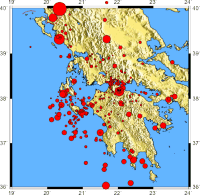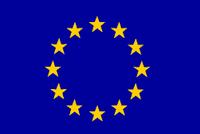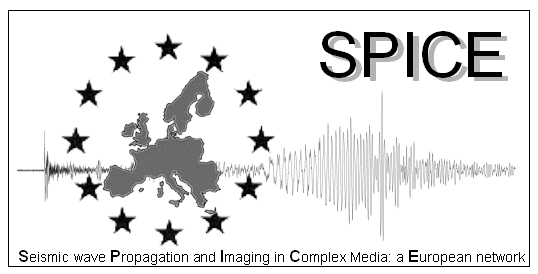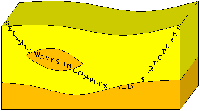DEPARTMENT OF GEOPHYSICS
Faculty of Mathematics and Physics, Charles University in Prague
DEPARTMENTAL SEMINARS
- Seminar of Geodynamics, WS 2007/2008 (mostly in Czech)
- Seminar of Seismology, WS 2007/2008 (mostly in Czech)

|
Seismic stations in Western GreeceCorinth Gulf separates the continental Greece from Peloponnese peninsula. It is believed to represent extensional tectonics (rift structure) characterized by recent horizontal motions as fast as a few millimeters per year. As such, it belongs to seismically most active regions of the Mediterranean. Last destructive event of M=6.2 occurred in the Gulf close to the city of Egio in June 1995. The city of Patras, hub of the western Peloponnese, was damaged by the 1993 earthquake. The key role in understanding those earthquakes, and predicting ground motions during similar future events, is played by detailed seismic observations. Western part of the Corinth Gulf has been monitored since 80's by PATNET, the short-period telemetered seismological network of the Patras University, covering the whole western Greece. Since November 1997, three broadband stations have been operating in the Gulf as a long-term temporary network, jointly managed by the Charles University (Prague, Czech Republic) and Patras University. For more information, visit seis30.karlov.mff.cuni.cz. |
 Thermochemical convection (AVI, 1 MB) |
GeodynamicsThe research of the geodynamic group covers a broad range of problems, such as:
|

|
MAGMA - Prague Centre for MAthematical Geophysics, Meteorology, and their ApplicationsThe goal of the project was to increase international recognition of geophysics and meteorology at the Charles University in Prague, and to finalize its integration into the European Research Area. The MAGMA centre aimed at contributing to the co-ordination of research and education in dynamic phenomena of the solid Earth and atmosphere by adopting unifying mathematical viewpoint and multidisciplinary approach. The main approach to achieve this objective was networking of researchers by means of organizing workshops, inviting distinguished lecturers, and hosting PhD students and post-doctoral researchers. Visit the MAGMA homepage. |

|
SPICE - Seismic wave Propagation and Imaging in Complex media: a European networkSPICE is a Marie Curie Research Training Network in the 6th Framework Program of the European Commission. The 4-year project started on January 1, 2004. The SPICE Consortium aims at integrating institutions with specialisations in physical, mathematical, geological, and computational aspects of seismic wave propagation. The goal is to develop, verify and apply computational tools for wave propagation and imaging problems on all scales. With the novel computational algorithms we expect breakthroughs in: the determination of global Earth structure; the quantitative estimation of shaking hazard; the characterization and monitoring of reservoirs; understanding the structure and processes inside volcanoes; simulating the physical processes of earthquake rupture; and characterizing the small-scale properties of rocks. The network undertakes to provide secondments for Early Stage and Experienced Researchers whose appointment will be financed by the contract. Recruitment of young researchers (mostly of pre-doc level) is underway - ESR vacancies in Prague! For details please visit the main SPICE homepage and the local SPICE homepage. |
